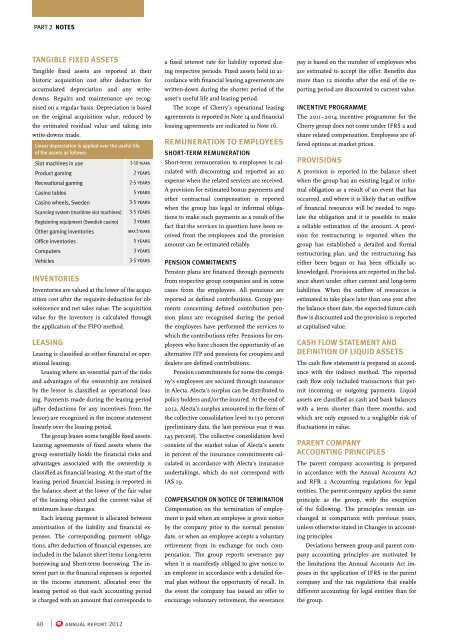Annual Report 2012.pdf - Cherry
Annual Report 2012.pdf - Cherry
Annual Report 2012.pdf - Cherry
You also want an ePaper? Increase the reach of your titles
YUMPU automatically turns print PDFs into web optimized ePapers that Google loves.
Part 2 notes<br />
TANGIBLE FIXED ASSETS<br />
Tangible fixed assets are reported at their<br />
historic acquisition cost after deduction for<br />
accumulated depreciation and any writedowns.<br />
Repairs and maintenance are recognised<br />
on a regular basis. Depreciation is based<br />
on the original acquisition value, reduced by<br />
the estimated residual value and taking into<br />
write-downs made.<br />
Linear depreciation is applied over the useful life<br />
of the assets as follows:<br />
Slot machines in use<br />
3-10 years<br />
Product gaming<br />
2 years<br />
Recreational gaming<br />
2-5 years<br />
Casino tables<br />
5 years<br />
Casino wheels, Sweden<br />
3-5 years<br />
Scanning system (maritime slot machines) 3-5 years<br />
Registering equipment (Swedish casino) 3 years<br />
Other gaming inventories<br />
max 5 years<br />
Office inventories<br />
5 years<br />
Computers<br />
3 years<br />
Vehicles<br />
3-5 years<br />
INVENTORIES<br />
Inventories are valued at the lower of the acquisition<br />
cost after the requisite deduction for obsolescence<br />
and net sales value. The acquisition<br />
value for the inventory is calculated through<br />
the application of the FIFO method.<br />
LEASING<br />
Leasing is classified as either financial or operational<br />
leasing.<br />
Leasing where an essential part of the risks<br />
and advantages of the ownership are retained<br />
by the lessor is classified as operational leasing.<br />
Payments made during the leasing period<br />
(after deductions for any incentives from the<br />
lessor) are recognized in the income statement<br />
linearly over the leasing period.<br />
The group leases some tangible fixed assets.<br />
Leasing agreements of fixed assets where the<br />
group essentially holds the financial risks and<br />
advantages associated with the ownership is<br />
classified as financial leasing. At the start of the<br />
leasing period financial leasing is reported in<br />
the balance sheet at the lower of the fair value<br />
of the leasing object and the current value of<br />
minimum lease charges.<br />
Each leasing payment is allocated between<br />
amortisation of the liability and financial expenses.<br />
The corresponding payment obligations,<br />
after deduction of financial expenses, are<br />
included in the balance sheet items Long-term<br />
borrowing and Short-term borrowing. The interest<br />
part in the financial expenses is reported<br />
in the income statement, allocated over the<br />
leasing period so that each accounting period<br />
is charged with an amount that corresponds to<br />
40 | annual report 2012<br />
a fixed interest rate for liability reported during<br />
respective periods. Fixed assets held in accordance<br />
with financial leasing agreements are<br />
written-down during the shorter period of the<br />
asset’s useful life and leasing period.<br />
The scope of <strong>Cherry</strong>’s operational leasing<br />
agreements is reported in Note 14 and financial<br />
leasing agreements are indicated in Note 16.<br />
REMUNERATION TO EMPLOYEES<br />
SHORT-TERM REMUNERATION<br />
Short-term remuneration to employees is calculated<br />
with discounting and reported as an<br />
expense when the related services are received.<br />
A provision for estimated bonus payments and<br />
other contractual compensation is reported<br />
when the group has legal or informal obligations<br />
to make such payments as a result of the<br />
fact that the services in question have been received<br />
from the employees and the provision<br />
amount can be estimated reliably.<br />
PENSION COMMITMENTS<br />
Pension plans are financed through payments<br />
from respective group companies and in some<br />
cases from the employees. All pensions are<br />
reported as defined contributions. Group payments<br />
concerning defined contribution pension<br />
plans are recognised during the period<br />
the employees have performed the services to<br />
which the contributions refer. Pensions for employees<br />
who have chosen the opportunity of an<br />
alternative ITP and pensions for croupiers and<br />
dealers are defined contributions.<br />
Pension commitments for some the company’s<br />
employees are secured through insurance<br />
in Alecta. Alecta’s surplus can be distributed to<br />
policy holders and/or the insured. At the end of<br />
2012, Alecta’s surplus amounted in the form of<br />
the collective consolidation level to 130 percent<br />
(preliminary data, the last previous year it was<br />
143 percent). The collective consolidation level<br />
consists of the market value of Alecta’s assets<br />
in percent of the insurance commitments calculated<br />
in accordance with Alecta’s insurance<br />
undertakings, which do not correspond with<br />
IAS 19.<br />
COMPENSATION ON NOTICE OF TERMINATION<br />
Compensation on the termination of employment<br />
is paid when an employee is given notice<br />
by the company prior to the normal pension<br />
date, or when an employee accepts a voluntary<br />
retirement from in exchange for such compensation.<br />
The group reports severance pay<br />
when it is manifestly obliged to give notice to<br />
an employee in accordance with a detailed formal<br />
plan without the opportunity of recall. In<br />
the event the company has issued an offer to<br />
encourage voluntary retirement, the severance<br />
pay is based on the number of employees who<br />
are estimated to accept the offer. Benefits due<br />
more than 12 months after the end of the reporting<br />
period are discounted to current value.<br />
INCENTIVE PROGRAMME<br />
The 2011–2014 incentive programme for the<br />
<strong>Cherry</strong> group does not come under IFRS 2 and<br />
share related compensation. Employees are offered<br />
options at market prices.<br />
PROVISIONS<br />
A provision is reported in the balance sheet<br />
when the group has an existing legal or informal<br />
obligation as a result of an event that has<br />
occurred, and where it is likely that an outflow<br />
of financial resources will be needed to regulate<br />
the obligation and it is possible to make<br />
a reliable estimation of the amount. A provision<br />
for restructuring is reported when the<br />
group has established a detailed and formal<br />
restructuring plan, and the restructuring has<br />
either been begun or has been officially acknowledged.<br />
Provisions are reported in the balance<br />
sheet under other current and long-term<br />
liabilities. When the outflow of resources is<br />
estimated to take place later than one year after<br />
the balance sheet date, the expected future cash<br />
flow is discounted and the provision is reported<br />
at capitalised value.<br />
CASH FLOW STATEMENT AND<br />
DEFINITION OF LIQUID ASSETS<br />
The cash flow statement is prepared in accordance<br />
with the indirect method. The reported<br />
cash flow only included transactions that permit<br />
incoming or outgoing payments. Liquid<br />
assets are classified as cash and bank balances<br />
with a term shorter than three months, and<br />
which are only exposed to a negligible risk of<br />
fluctuations in value.<br />
PARENT COMPANY<br />
ACCOUNTING PRINCIPLES<br />
The parent company accounting is prepared<br />
in accordance with the <strong>Annual</strong> Accounts Act<br />
and RFR 2 Accounting regulations for legal<br />
entities. The parent company applies the same<br />
principle as the group, with the exception<br />
of the following. The principles remain unchanged<br />
in comparison with previous years,<br />
unless otherwise stated in Changes in accounting<br />
principles.<br />
Deviations between group and parent company<br />
accounting principles are motivated by<br />
the limitations the <strong>Annual</strong> Accounts Act imposes<br />
in the application of IFRS in the parent<br />
company and the tax regulations that enable<br />
different accounting for legal entities than for<br />
the group.



